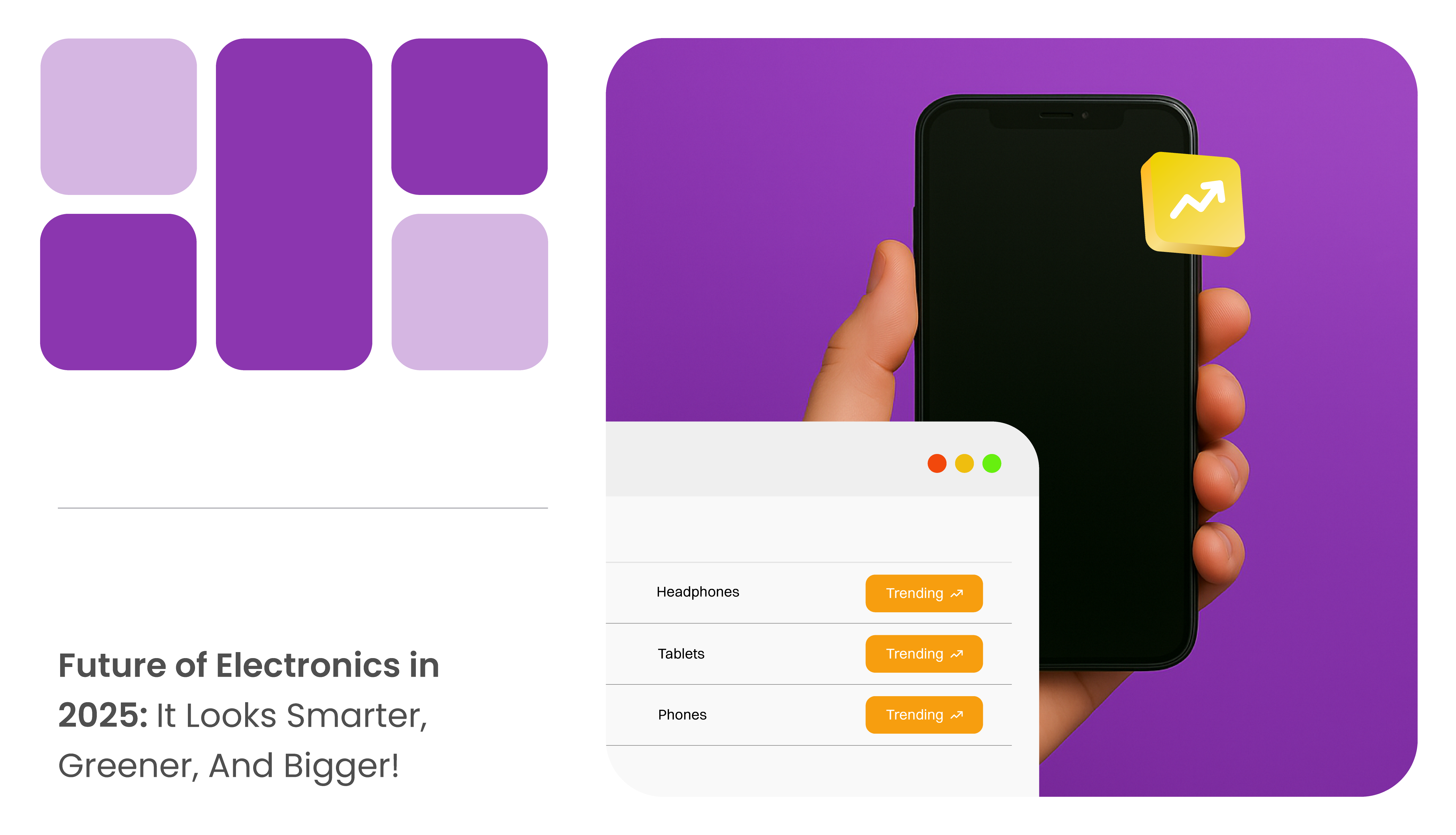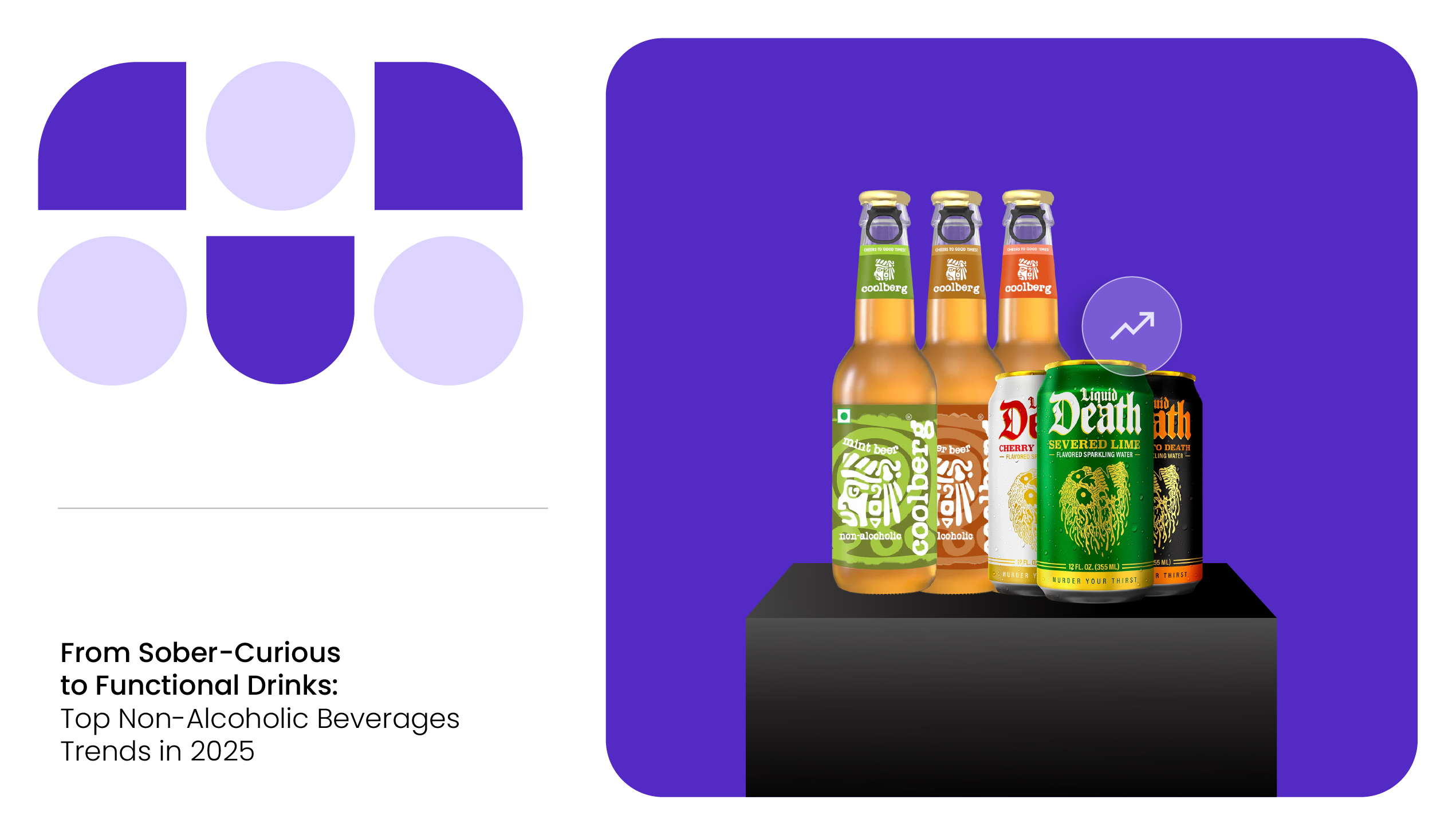Let’s not sugarcoat it: 2025 is a make-or-break year for the electronics category.
The global consumer electronics market is expected to hit $1 trillion by 2031, and in the US alone, it is forecasted to reach over $261,929 million in 2030.
What’s driving this? Five words: smarter, greener, more connected tech. We’ve already entered the future of electronics!
It is shaped by rapid technological advancement, tightening environmental regulations, and a new generation of digital-native consumers, who expect their devices to be intelligent, efficient, and sustainable by default.
Consumer Expectations: What’s Plugged In For 2025?
Consumer expectations have shifted. Smart is no longer a bonus; it’s the baseline.
Whether it’s a refrigerator that reorders your groceries, a wearable that tracks your sleep and stress, or a thermostat that trims your energy bill without lifting a finger, the demand for intelligent tech is baked into purchasing decisions.
At the same time, sustainability is front and center. While remaining price-sensitive, around 75% of consumers are making decisions based on a product’s environmental footprint, lifecycle, and energy usage.
The pressure on brands to deliver products that are not just powerful but also planet-conscious has never been greater.
This shift in consumer expectations is not just limited to electronic products. It extends to the retail ecosystem, where e-commerce, mobile, and in-store shopping are fully merged into hybrid journeys.
It’s clear that brands that don’t rethink their product experience and data strategy will be left behind.
Let’s have a deeper look at the key electronics trends driving the future of electronics in 2025.
READ MORE| What’s driving online shoppers in the US in 2025? Check out 50 Key Online Consumer Statistics In 2025: Numbers You Can’t Miss!
Key Electronics Trends 2025
With 2025 shaping up to be a turning point for consumer tech, the most impactful innovations are already shaping buyer behavior and retail strategy.

Below, we break down the key trends in the electronics category that are defining the industry’s future.
1. AI and Personalization
AI is no longer a buzzword; it’s embedded in everyday consumer tech. In 2025, consumers expect their devices to anticipate needs, adapt to behavior, and streamline routines.
Platforms like LG’s AI concierge and Samsung’s SmartThings ecosystem are doing more than managing appliances. They’re learning from user habits and adjusting automatically.
This means smarter automation at the device level. LG’s AI concierge, for instance, not only manages appliance settings but also suggests ways to save energy based on usage patterns.
Samsung’s SmartThings ecosystem creates a living environment that responds dynamically to individual behaviors; lights dim when the TV turns on, air purifiers adjust based on detected allergens, and routines sync with calendar events.
More examples include refrigerators that are now smart enough to track inventory and reorder essentials. Voice assistants are learning to anticipate questions before they’re asked. TVs personalize recommendations based on who’s watching.
This level of AI-driven personalization isn’t just convenient; it’s now expected.
2. Home Energy-Efficiency Devices
There’s a shift happening in home electronics – functionality is being matched by energy efficiency. Buyers want devices that lower bills and reduce environmental impact.
Energy-efficient appliances like AI washers, smart thermostats, and connected dishwashers are in high demand.
Samsung’s AI washer learns user patterns to optimize water and is 40% more energy-efficient without compromising wash quality. Nest’s learning thermostat adapts to daily routines, cutting heating and cooling costs by 10% or more.
Incentive structures are also reinforcing this shift. Utility companies across the US are partnering with manufacturers to offer rebates and dynamic pricing programs. Devices enrolled in peak-reduction programs can automatically scale back energy use during high-demand periods, creating a win-win for both households and the grid.
As energy prices and climate awareness grow, energy-efficient tech is becoming a core driver of consumer decision-making.
READ MORE| Amazon’s electronics category reveals fascinating consumer trends! Check out Electronics on Amazon: Insights From Black Friday and Cyber Monday Shopping Frenzy to know more!
3. Super-Sized TVs and Displays
Visual real estate is getting a serious upgrade in 2025. Large-format displays are no longer niche or aspirational; they’re mainstream. The consumer shift toward streaming, home entertainment, and gaming has spiked demand for immersive, high-fidelity displays.
Advancements in MicroLED and QD-OLED technologies are leading this charge. These displays offer higher brightness, wider color gamuts, and greater power efficiency compared to legacy panels.
The growing role of content, especially in 4K and 8K formats, is pushing consumers toward displays that can handle it. Refresh rates of 120Hz or higher, low input lag, and adaptive sync technologies are now essential features, particularly in the gaming segment.
For retailers and brands, this means more complex product education and richer digital content to support conversion. Enhanced product demos, AR previews, and video explainers are becoming standard for display marketing.

4. Advanced Sensor Tech for Home and Health
Sensors are quietly becoming the backbone of next-gen electronics. In 2025, sensor technologies are enabling real-time, personalized feedback in health, wellness, and home environments.
Health wearables now track hydration levels, blood oxygen, glucose trends, stress indicators, and more. These insights are no longer siloed; they integrate into larger wellness ecosystems, providing users with actionable data.
Products like the Hormometer allow consumers to monitor hormone fluctuations with saliva-based testing, helping personalize exercise and diet routines.
At home, environmental sensors are enhancing quality of life. Air quality monitors adjust purifiers based on indoor pollution levels. Smart mirrors assess skin health and suggest routines. Beds embedded with pressure and temperature sensors adapt throughout the night for better sleep cycles.
The key shift is scale. What was once premium is now accessible. And with integration into mobile apps and voice assistants, this tech is becoming part of consumers’ daily routines.
5. Sustainability in Consumer Tech
Sustainability is moving from a marketing claim to a product requirement. In 2025, consumers are actively evaluating electronics based on environmental impact, from materials and packaging to product longevity.
Modular design is gaining traction. Devices like Compal’s Adapt X laptop allow users to replace or upgrade specific components without replacing the entire device, reducing both cost and e-waste. Major brands are expanding repairability programs and investing in certified recycled materials.
E-commerce platforms are featuring product sustainability data directly in search filters and product pages. Carbon footprint disclosures, packaging impact metrics, and third-party certifications are influencing conversions.
Manufacturers are also rethinking end-of-life strategies, offering trade-in programs, recycling options, and transparent take-back policies. These efforts are increasingly critical for capturing eco-conscious consumers and for aligning with emerging regulatory frameworks.
READ MORE| For Gen Z, sustainability is a key purchase decision driver! Check out Gen Z Sustainability Trends: How E-Commerce Brands Can Stay Relevant to learn more!
6. Hybrid Shopping Experience
The line between online and offline shopping is gone. In 2025, electronics purchases are increasingly happening through hybrid experiences that merge convenience, personalization, and real-time information.
Going phygital, shoppers might start with a mobile search, visit a store to compare models, scan QR codes for demo videos, and finalize purchases via branded apps. Retailers are enabling this through technologies like endless aisle systems, RFID tags, and personalized promotions triggered by in-store interactions.
At CES 2025, demonstrations included smart shelves that display custom pricing based on loyalty status, and NFC-enabled tags that sync with a user’s purchase history to recommend compatible accessories.
This omnichannel model requires unified product data, consistent brand messaging, and seamless checkout experiences. Retailers and manufacturers investing in backend integration are finding greater engagement, lower return rates, and stronger loyalty.
MetricsCart’s digital shelf analytics gives you a real-time view of how your products perform across every digital shelf. With actionable insights on pricing, availability, content, and competitor moves, we help brands stay sharp in today’s omnichannel retail game.
Final Notes
The electronics category trends we’re seeing aren’t just shaping the market; they’re redefining the rules of competition, value creation, and consumer connection. The lines between product and service, device and lifestyle, store and screen are blurring and that too, real fast.
What’s clear is that innovation alone isn’t enough. Success now depends on how well a brand understands its audience, anticipates expectations, and delivers value in a seamless, responsible, and data-informed way.
Every touchpoint, from how a product is discovered to how it’s used and recycled, is all part of the experience.
The brands leading in 2025 won’t just react to change. They’ll drive it by treating sustainability as a strategy, AI as infrastructure, and omnichannel presence as a necessity.
This is the moment to recalibrate. Because the future of electronics isn’t waiting, it’s already in your cart, your app, and your home.
Want to own the digital shelf in 2025? MetricsCart helps you track, manage, and optimize your product visibility across every channel. From pricing intelligence and review tracking to content compliance and stock monitoring, we provide the insights you need to stay competitive on the digital shelf.
Ready to scale smarter, faster, cleaner? Get in touch today!
Every Second Counts! Strengthen Your Business With Our Digital Shelf Solutions.
FAQ
AI personalization, home energy tech, massive displays, health sensors, sustainability, and hybrid retail experiences are leading 2025.
AI integration, energy-efficient appliances, smart wearables, sustainable design, and immersive shopping experiences.
Consumer electronics, smart home devices, wearable health tech, green tech, and retail tech platforms.
Smart TVs, energy-saving appliances, AI-enhanced health monitors, and AR/VR devices.
As of 2024, US electronics stores held a $156.6B share. Market growth in 2025 is being fueled by the smart home and health tech segments.







